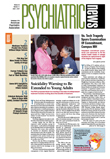Portable pulse oximetry is an inexpensive ($400-$600) and noninvasive procedure that measures oxygen saturation in five to 10 seconds. It has potential as a prevention strategy to identify patients with acute oxygen deficits that can occur during mechanical or physical restraints, such as when a patient is held by staff.
The Joint Commission's 1994-2005 summary of sentinel events in its accredited facilities found 130 of them were related to use of restraints in adults and children. The proximate cause of morbidity or mortality in many of these cases was asphyxiation. In a different study of 45 deaths of children and adolescents during physical restraints, 29 (64 percent) were found to be associated with asphyxiation.
Hoping that pulse oximetry might detect ox ygen-saturation deficits, we began to use it routinely three years ago in all restraints in six adolescent/child residential and hospital programs.
Oximetry was measured on admission to obtain a baseline; during restraints to assess cardio-respiratory status, and several minutes after the restraint ended to detect possible bronchospasm.
Additional oxygen saturation measurements were obtained whenever a patient requested one, if staff members were concerned about the patient's cardio-respiratory status, or when a patient fell asleep or became quiet. We set acceptable oximetry saturation as 95 percent or above. To date we have found six abnormally low saturation readings. In the most worrying case, an adolescent in a standing physical hold had a 70 percent (critical) saturation level.
We found no increase in the length or number of restraints when oximetry was used. Instead it appeared that there were psychological restraint-prevention benefits to the procedure, including that admission discussion of oximetry increased patient and family awareness of potential medical risks of restraint and that the use of oximetry sometimes ended a restraint, particularly when the patient was permitted to take his/her own saturation readings. We also found that it heightened staff concerns about medical complications and that sometimes patients' resistance to oximetry measurements was a sign of underlying depression, or as in one case, of suicidal thoughts that had not been previously detected but were expressed when objection to permitting an oxygen-saturation reading was processed.
Pulse oximetry should always be incorporated into restraint-reduction programs to prevent it being used to justify restraints as safe procedures, when its purpose is to prevent asphyxiation and emphasize the medical dangers of restraints. Our protocol requires explanation about the use of oximetry during restraints to patients, and in the case of minors, to guardians. This can help increase public awareness of the dangers of restraints, their monitoring requirements, and restraint-reduction efforts are currently being used at the facility.
We recently completed an APA online grand rounds on a seclusion-and-restraint case that included a discussion of pulse oximetry occurred. Dr. Frank Guerra, a professor of anesthesiology and psychiatry at the University of Colorado, provided very helpful clinical information about the importance of pulse oximetry and indicated that its use for monitoring oxygen saturation during restraints was clinically appropriate. The case and the discussion are available on the APA Web site<www.psych.org> in the Members' Corner under “APA Grand Rounds.”
In summary, the monitoring of behavioral restraints has really not incorporated modern technology. Indeed, one could have taught Pharaoh Tutankhamun how to count pulse and respiration rates! Blood-pressure monitoring is a newer technology but it is often difficult to measure blood pressure in an agitated person. Furthermore, all of these procedures are secondary measurements of oxygen-saturation levels. Pulse oximetry, on the other hand, is a primary measure of oxygen-saturation deficit and therefore should provide more timely information that might prevent medical catastrophe.
There is no funding for this “pulse oximetry initiative”; nor is there research network that can provide supportive data. However, oximetry is used in many hospital settings from emergency rooms to pediatric units to monitor oxygen saturation in the medically ill. If oximetry is to be made available to patients who are restrained in the context of psychiatric care, the impetus will have to come from psychiatrists as individuals, groups, district branches, and maybe even the national APA. Please consider joining me in this effort.
I would be pleased to share our protocol and other information with the hope that it might be of interest to readers and hopefully also to collect anecdotal information from those who use this procedure.
